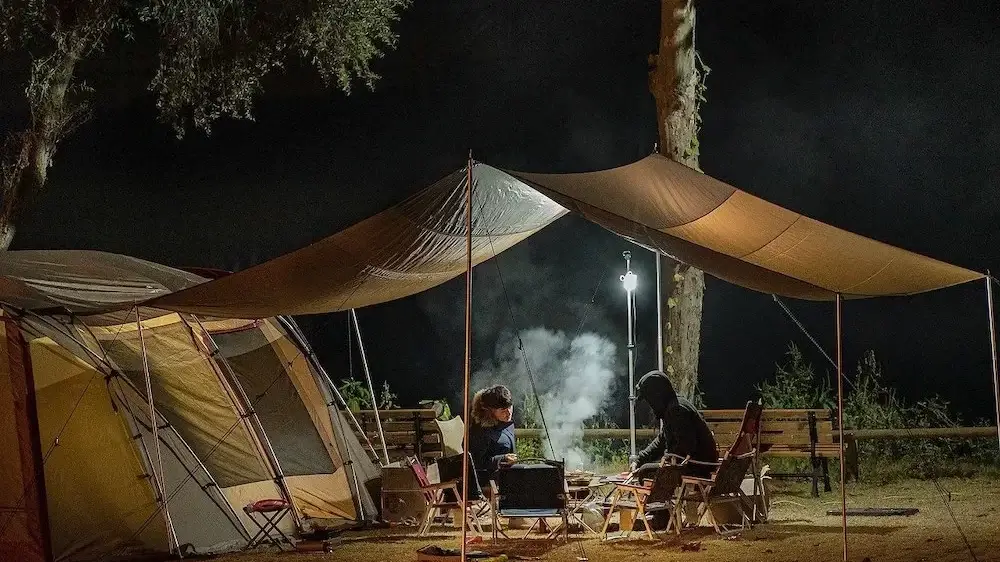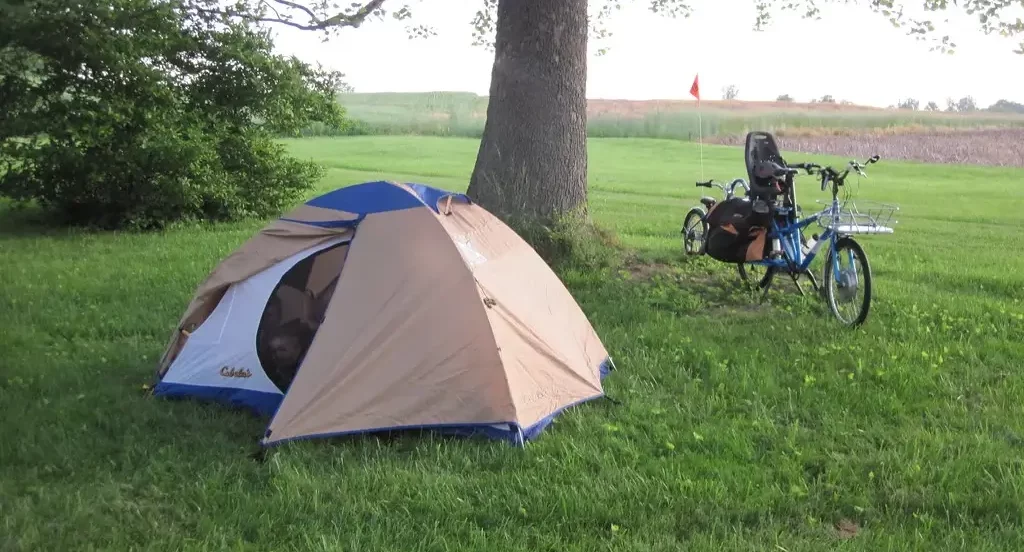How to cool a tent without electricity? A hot tent can be a tough thing to sleep in, especially when you’re camping out in the summer heat.
Summertime is the perfect time for family camping trips, but if you’re like many people, you may not have access to electricity at your campsite. This can leave you struggling to find a way to cool down your tent during the hot summer days.
Luckily, there are a few things you can do to help keep your tent cool without power. Keep reading for some tips on how to beat the heat while camping!
Why Does a Tent Often Get Too Hot to Stay In?
The answer is simple: the materials used for construction. We all know that polyester provides excellent water resistance, but did you also consider just how quickly these fabrics breathe and lose their insulating properties when wet or damp?
When air cannot flow through them easily this means they won’t be able to hold onto as much heat energy either – which has huge consequences on our comfort levels at night time.
It’s about more than just trapping too much heat, however. Tents are built to be durable and provide shade from the sun (and rain) during the day, but these same properties also make them great insulators at night time.
This means that all of those watts we’re using for lighting, charging gadgets, and running appliances are staying put, heating up our small living space in the process.

There are a few things you can do to help keep your tent cool at night:
- Make sure that all of your windows and doors are closed when the sun goes down. This will trap cooler air inside and create a more comfortable environment to sleep in.
- Keep the door and windows open when it’s sunny out to let all of that hot air escape. If you’re worried about mosquitos getting inside then simply spray some repellent around your entry points before opening them up.
- Use a sleeping pad or extra camping mattress under your tent so there is another layer of insulation between you and the ground.
- Consider leaving your tent flap open during the day to let some of that hot air escape. Just make sure that no one or nothing can enter through it by accident – we don’t want any uninvited guests ruining our sleep time either.
Also Read: 3 Season vs 4 Season Tent: Which One Should You Choose?
The 8 Smart Ways to Cool a Tent without Electricity
When the weather is hot and you’re inside a stuffy tent, it’s easy to feel overheated. Tent walls trap the heat and create an uncomfortable environment.
The best way to avoid this is by taking some simple precautions before you set up your campsite.
1. How to Choose a Perfect Tent for Hot Weather?
In hot weather, a tent can quickly become an oven. The sun shining on the fabric will heat it up and the inside of the tent will become incredibly hot.
If you’re not prepared for this, you might find yourself uncomfortable and struggling to sleep in your own tent. Here are some tips for choosing a perfect tent for hot weather.
The first thing to consider is the material of the tent. You’ll want a fabric that will reflect the sun’s heat, such as canvas or nylon. Mesh panels will also allow for ventilation and keep the inside of the tent cool.
Make sure to choose a tent with plenty of mesh panels if you’re going to be using it in hot weather.
The next thing to consider is the size of the tent. A larger tent will be cooler than a smaller one because there will be more surface area for the sun to heat up.
If you’re going to be using your tent in very hot weather, it’s best to choose a model that’s specifically designed for hot climates.
Finally, pay attention to the climate you’ll be using your tent in. If you’re going to a hot and humid area, look for a tent with a waterproof and breathable canopy. This will help prevent the inside of the tent from becoming too sweaty and stifling.
Experts Opinion
When you go camping, a light color tent is best to stay cool. The dark colors absorb the heat from the sun and keep it inside your tent.
This can lead to overheating during hot summer days or being too cold at night when temperatures drop below freezing. Most tents are available in a variety of colors so that one should not be too difficult to find.
The best color for a summer tent is the lightest one you can purchase and will stay cool during your camping trip.
There are many brands that offer these lighter colors, but another option is to choose a white or light-colored tarp as an inexpensive alternative if you do not want to invest in a new tent.
2. Choose the Perfect Tent Site
The first step is to choose the perfect tent site. Find a spot that is shady with good airflow. Avoid camping near trees, as their branches will cast shade on your tent and make it even hotter inside.
If you can’t find a shady spot, try setting up your tent so that the door faces east or south instead of west, which will trap less heat.
If you are camping in an area with high humidity, try to find a site that is on higher ground so it won’t collect too much moisture.
3. Set up the Tent at a Perfect Time
The best time to set up your tent is in the early morning or evening when the sun isn’t as strong. During the day, try to find a spot that is in the shade.
Planning your camping trip is a lot more fun when you know how to set up the tent at just the right time. The first step before heading out on any outdoor adventure, be sure that weather permits and everything is in order for success.
Once you have arrived at your campsite, take a few minutes to survey the area before setting up your tent.
Choose a spot that is level, dry, and free of obstructions. Avoid setting up your tent near large trees or under power lines, as these can create areas of high heat.
Unless you’re in a hurry, always take the time to stake down your tent properly. This will help keep it from blowing away in strong winds and also make it more stable in case of rain.
4. Hanging the Rainfly Over the Tent
When the sun is beating down on your tent, it can get unbearably hot inside very quickly. This happens because the rainfly (the waterproof covering that goes over the top of the tent) is not doing its job properly.
The rainfly should be hanging as close to the ground as possible in order to create a shady space underneath. When it is hanging too high, the sun can penetrate through it and heat up the tent.
If you are struggling to keep your tent cool during hot weather, try adjusting the height of your rainfly. You may also want to consider using a sunshade to provide some extra shade for your tent.
Sunshades attach easily to the side of your tent and are specially made to provide sun protection.
5. Unzipped the Tent Door/Windows
Unzipped, I was able to let some cool breeze in and it wasn’t long before things cooled down a bit. To keep the temperature under control, you’ll need to do this at least once an hour – if not more often.
One of the biggest causes for a tent becoming overheated is poor design and lack of airflow. If you find yourself in this situation try opening up your vents (if you have them) or unzipping your doors/windows.
Unzipping the tent door/windows is also a great way to avoid waking up cold in the morning – bonus.
6. Take an Advantage of Tree Cover

When camping, one of the biggest advantages of pitching your tent under a tree is the natural shade it provides.
Not only will this keep you cooler during the hot summer months, but it can also help protect your tent from UV rays and extend its life.
In addition to the shade, another great benefit of camping under a tree is the protection it offers from the wind.
This can be especially helpful if you are in an area that experiences high winds, as it can help keep your tent from being blown away.
Finally, pitching your tent near a tree can also provide some added security. If you are in a campground, it can help keep your gear safe from theft by blocking the view of thieves.
In addition to this, if you have food or scented items such as toothpaste or soap that may attract animals while camping, this added protection is also beneficial.
7. Shut down the Tent in Daylight
When you are in a tent, it is very important to close the flaps and zip up the door when it is light outside.
The sun can cause the inside of the tent to heat up and make it uncomfortable to sleep. By shutting down the tent in daylight, you can keep cool and comfortable while you rest.
In addition, shutting down the tent will keep out bugs and other pests. Make sure to close all the flaps and zip up the door so that no critters can get inside.
Having a good night’s sleep is important when you are camping. If you have a great night’s sleep, you will be well-rested and ready to enjoy your day outside.
8. Carrying a Portable Rechargeable Fan
A rechargeable Fan is a great way to keep cool. Not only does it provide relief from the summer heat, but it can also help improve morale by keeping everyone in the tent cooler.
In addition, a fan can be used to circulate fresh air and help reduce moisture levels inside the tent.
When selecting a portable rechargeable fan for your next campaign, be sure to consider the following factors:
Type of Fan – There are a variety of fans on the market, from small personal fans to large floor fans. Choose the type that best meets your needs.
Battery Type and Power – Make sure the fan you choose uses a battery that can be easily recharged. Also, check to see how much power the fan consumes so you can be sure your battery will last long enough.
Weight and Size – Fans come in a variety of weights and sizes, so be sure to choose one that is easy to transport.
Additional Features – Some fans come with additional features such as lights or a USB port for charging devices. If these features are important to you, be sure to choose a fan that has them.
Conclusion
By following the tips in this post, you can stay cool and comfortable while camping without electricity. By using strategies such as unzipping the door/windows, taking advantage of tree cover, and shutting down the tent in daylight, you’ll be well on your way to a fun and relaxing trip.
Additionally, be sure to bring along a portable rechargeable fan to circulate fresh air and keep you cool. With these tips, you’ll be able to enjoy your camping trip even in the hottest weather!

